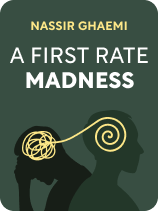

This article is an excerpt from the Shortform book guide to "A First Rate Madness" by Nassir Ghaemi. Shortform has the world's best summaries and analyses of books you should be reading.
Like this article? Sign up for a free trial here.
How can leaders be more innovative at work? How does mania improve innovative thinking?
Leadership and innovation go hand-in-hand, but an unexpected factor in this connection is mania. The mental illness promotes creative thinking, supporting new ideas, and solving complex problems that may go unnoticed.
Here’s more on why A First-Rate Madness by Nassir Ghaemi believes mania enhances your ability to be an innovative leader.
Mania Improves Innovative Thinking
Mania can enhance leadership and innovation, allowing people to generate innovative solutions to unprecedented challenges. Ghaemi defines creativity as the ability to both come up with inventive solutions and detect key problems that others fail to notice.
(Shortform note: While mania may help those with manic depression or hyperthymia generate more creative solutions, there are ways you can actively cultivate more creativity in your life. In the Little Red Book of Selling, Jeffrey Gitomer says you must first believe in your potential to generate creative ideas to be in an innovative state of mind. He suggests you further develop your creativity by creating a stimulating workspace, being open to failure, and getting in the habit of writing down ideas.)
According to Ghaemi, symptoms of mania promote divergent and complex thinking, making people more aware of nuances that encourage new insights. This enhanced creativity allows leaders to break free from traditional approaches and to generate new solutions, both important when navigating unprecedented conflicts. Ghaemi argues that mentally well leaders, on the other hand, tend to be more confined to conventional strategies that are reliable for peacetime politics but disadvantageous during crises.
(Shortform note: The idea that mania directly results in increased creativity is still debated. In a group of bipolar patients, one study found that only 8% of them could be considered highly creative. However, other studies suggest at least a correlation between bipolar disorder and creativity that hints at a causal link. Studies have found an overrepresentation of bipolar disorder in creative occupations compared with the general population. Researchers suggest one reason why mania may enhance creativity: Mania causes your brain to release higher levels of dopamine, which allows you to take in more stimuli from your surroundings and thereby enhances your ability to think creatively.)
Example: General Sherman and the Civil War
In the 1860s, the American Civil War tested the leadership of Union Army General William T. Sherman. Ghaemi contends that General Sherman likely suffered from bipolar disorder, which gave him the innovative thinking skills needed to invent a new strategy of war that was instrumental to securing the Union victory.
Drawing from reports of the time, Ghaemi concludes that Sherman likely suffered from episodes of mania and depression. Ghaemi argues that these episodes allowed him to look beyond the traditional warfare tactics that involved direct confrontations between two armies. Instead, he realized the need to alter his approach, launching an innovative “total war” campaign to march through the South and target the region’s land and resources, resulting in the scorched-earth “March to the Sea” he’s remembered for.
| Sherman’s March: An Attack on Confederate Morale Like Ghaemi, many historians consider Sherman a visionary military commander for his time, arguing that his approach during his March to the Sea resembled the warfare that would be conducted nearly a century later during the 20th-century world wars. One reason Sherman’s approach was so revolutionary was that it was psychological. Rather than aim to defeat the Confederates solely through battlefield combat, Sherman sought to bring an end to the war by destroying their morale. His approach differed from how the Union had been waging war thus far—the Union fought a limited war that left Confederate property and enslaved people unharmed. During Sherman’s march through Georgia, however, he directly targeted public property and military resources to deplete Confederate morale, yet he still avoided direct attacks on civilians and their individual homes. It was this innovative thinking that Ghaemi pegs as a product of his bipolar disorder. |

———End of Preview———
Like what you just read? Read the rest of the world's best book summary and analysis of Nassir Ghaemi's "A First Rate Madness" at Shortform.
Here's what you'll find in our full A First Rate Madness summary:
- How mental illness can make someone a better leader
- How leaders like Churchill and Roosevelt benefited from mental illness
- The pitfalls of being a mentally well leader during a time of crisis






